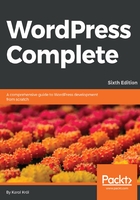
What this book covers
Chapter 1, Introducing WordPress, explains what makes WordPress excellent software that can run your website (blog or not). WordPress is packed with world-class features and is so flexible that it can really do anything you want. It has a wealth of online resources. Additionally, it's super easy to use, and you need no special skills or prior experience to use it. Last but not least, it is free!
Chapter 2, Getting Started with WordPress, describes how to install WordPress on a remote server, change the basic default settings of your blog, write posts, and comment on those posts. This chapter also shows you how to work with sites hosted on WordPress.com, which is one of the branches of the WordPress world.
Chapter 3, Creating Blog Content, teaches everything you need to know in order to add content to your blog and then manage that content, be it posts, categories, and comments, or tags, spam, and excerpts.
Chapter 4, Pages, Media, and Importing/Exporting Content, explores all the other types of content that WordPress is capable of handling. You'll be able to create static pages that aren't a part of your ongoing blog, add various types of media to your posts, and create appealing image galleries to display photos and other images (working with the new media library).
Chapter 5, Plugins - What They Are and Why You Need Them, explains what plugins are, why to use them, how to use them, where to get them, and how to be up-to-date with any new and useful plugins that get released to the community.
Chapter 6, Choosing and Installing Themes, describes how to manage the basic look of your WordPress website. You also get to learn where to find themes, why they are useful, and how to implement new themes in your WordPress website.
Chapter 7, Customizing Your Website Appearance/Design, explores how to manage widgets, navigation menus and work with the basic layout customization features to further enhance the capabilities of your entire website. Also covers the WordPress Customizer--an easy to use interface that allows you to tweak how your current theme looks and performs.
Chapter 8, Developing Your Own Theme, explains how to create your own theme. With just the most basic HTML and CSS abilities, you can create a design and turn it into a fully-functional WordPress theme.
Chapter 9, Social Media Integration, Podcasting, and HTTPS, explores social media integration, podcasting, and HTTPS, which is all about making your website more secure by adding an additional level of encryption to the browser-website communication.
Chapter 10, Developing Plugins, Widgets, and an Introduction to the REST API, teaches everything you need to know about creating basic plugins and widgets: how to structure the PHP files, where to put your functions, and how to use hooks. This chapter also teaches you how to add management pages and build widgets that are run by a plugin.
Chapter 11, Community Blogging, explains how to manage a group of users working on a single blog, which is a community of users. Community blogging can play an important role in a user group or a news website. This chapter also explains how to manage the different levels of privileges for users in the community.
Chapter 12, Creating a Non-Blog Website, Part One – The Basics, explores the endless possibilities of WordPress when it comes to using it to launch various types of websites. This chapter presents the first batch of our non-blog websites and explains in detail how to build them on top of a standard WordPress installation.
Chapter 13, Creating a Non-Blog Website Part Two - E-Commerce Websites and Custom Content Elements, goes through some additional types of non-blog websites and also presents some technical aspects of building them (caution--code talk inside).